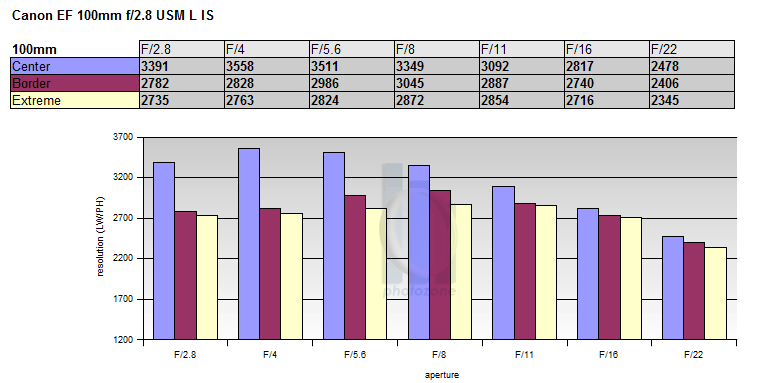|
Canon EF 100mm f/2.8 USM L IS macro (Full Format) - Review / Test Report - Analysis |
|
Lens Reviews -
Canon EOS (Full Format)
|
|
Page 2 of 3

Distortion
Typical for most macro lenses the level of distortion is absolutely negligible and nothing to worry about.

The chart above has a real-world size of about 120x80cm.
Vignetting
The amount of vignetting comparatively moderate on a full format body but in absolute terms it's still very pronounced at f/2.8 (1.5EV). The problem is significantly improved at f/4 and negligible from f/5.6 onwards.

MTF (resolution)
The resolution characteristic of the Canon L lens is very good although it did fall a little short of the high expectations that we had here. That's certainly not valid for the center quality which is excellent all the way up to f/8 but unfortunately the borders aren't quite on that level - they are "only" good to very good at f/2.8 and they reach their maximum at f/8. Starting from f/11 onwards there's the general decrease in quality due to diffraction effects. However, the lens remains easily usable at f/16. f/22 is a borderline setting in terms of quality but it's not all that bad.
Please note that the MTF results are not directly comparable across the different systems!
Below is a simplified summary of the formal findings. The chart shows line widths per picture height (LW/PH) which can be taken as a measure for sharpness.
If you want to know more about the MTF50 figures you may check out the corresponding Imatest Explanations

Chromatic Aberrations (CAs)
Lateral CAs are generally well controlled with less than 1px on the average at the image borders. At 100% magnification you may spot this but it shouldn't be a problem on prints.

Bokeh
The bokeh (the quality of the out-of-focus blur) is a primary aspect for a macro lens and the Canon lens does truly shine here. Out-of-focus highlights are very uniform and perfectly circular till f/5.6. The critical focus transition zones are very smooth at max. aperture. It's one of the best lenses in this respect that we've seen so far.

Bokeh Fringing / Longitudinal Chromatic Aberrations (LoCA)
Bokeh fringing is a common problem present in most large aperture lenses and despite its UD element the 100mm L IS is no exception to the rule here unfortunately. At f/2.8 the fringing is quite significant - if you observe the provided sample crops below you will be able to spot the green (rear) & purple (front) halos in the focus transition zones. They are quite pronounced at f/2.8. The situation improves at f/4 and the problem is basically gone from f/5.6 onwards.
|
Move the mouse cursor over the f-stop marks below to observe the respective LoCAs
|
| f/2.8 |
f/4 |
f/5.6 |
|

|
Here's a real world example of the problem (at f/2.8):

|